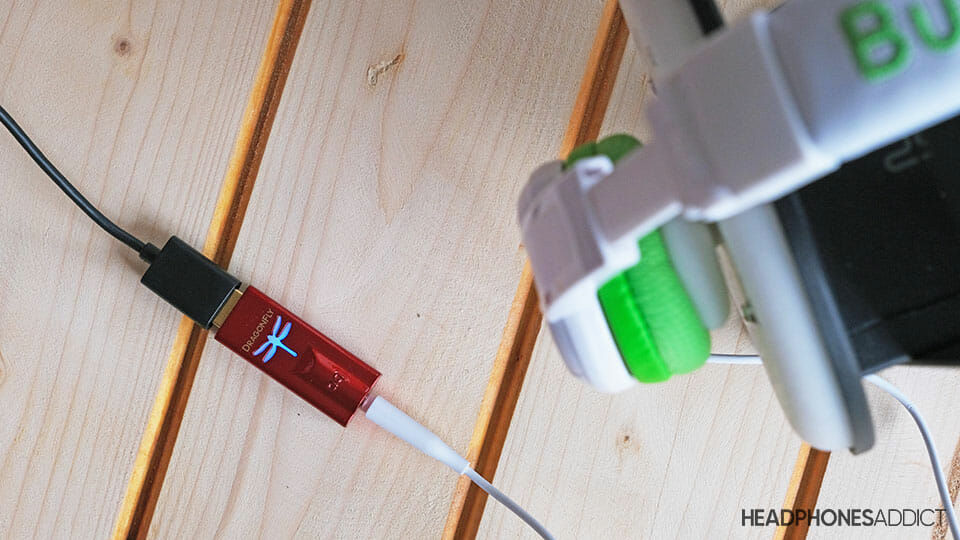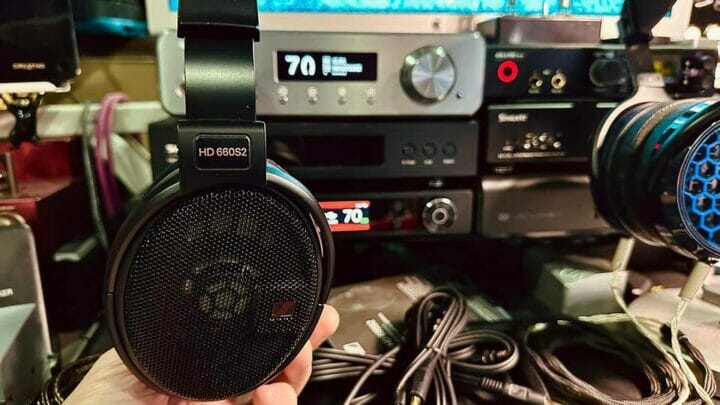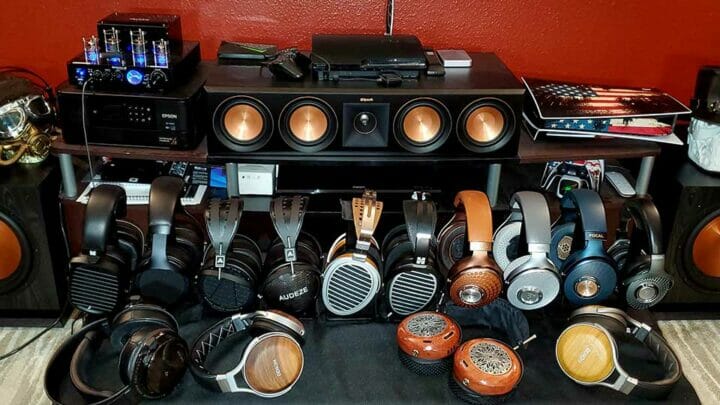An amplifier takes a weak signal and boosts it by adding more voltage. In the case of headphone amps, they increase the loudness of your headphones to a listenable volume.

KEY TAKEAWAY
- You don’t need an external amp if you’re using consumer-grade or modern headphones typically designed to work sufficiently through portable devices.
- You need an external amp if your headphones are too quiet, sound distorted, or have audible background noise.
- To determine whether you need an amp, insert your headphones’ impedance and sensitivity in this calculator and see if your existing amp can drive them to at least 110dB.
- Even a quality headphone amp can’t fix poor sound quality. It can make the sound slightly more controlled and detailed, but only sometimes.
Do You Need an Amp?
Do you need an amp? Yes. Do you need to buy an expensive external amp? Mostly no.
Let’s clear up a few things first. An amplifier is an essential part of any audio system, from room speakers to headphones.
Audio source devices, from analog turntables or digital CD players, have a built-in DAC to convert digital to analog audio signal. Often they output a fairly low voltage audio signal that needs boosting.
That’s where amps or amplifiers come in. Their main job is to boost the weak input signal. Amps are a part of everything that outputs sound. But sometimes isn’t strong enough.

Just like with a modern DAC (digital to analog converter), the main question is whether you need an external headphone amp or if a built-in one inside your laptop/audio dongle is fine.
When do you NOT NEED an expensive external amp?
You don’t need an expensive amp when using most consumer-grade headphones, as they work sufficiently with portable devices.
If you own a modern computer or Apple/Samsung audio dongle, you don’t need to rush out to buy an expensive amp.
Bluetooth headphones are also excluded from needing an external amp as they already have one built-in.
When do YOU NEED a more powerful external amp?
You need a stronger amp when the existing one can’t properly drive your power-hungry headphones. Either when:
- Headphones are too quiet.
- The sound is unexpectedly soft.
- You can hear an audible background noise (noise floor), which could result from cheap circuitry.
You must inspect the specifications to find out how power-hungry your headphones are. In there, you should see two values: impedance and sensitivity.
- The first one tells you how much headphones resist an electrical current.
- The second one tells how loud headphones can get at 1 milliwatt or 1 volt of voltage.
How powerful are built-in amps?
An average consumer audio device outputs slightly below 50mW of peak power (or 31.6mW of sustained one). The output power can vary between devices, but this is a general value.

Let’s take Sennheiser HD 650, supposedly hard headphones to drive due to their 300 ohms of impedance. However, they have high sensitivity of 103dB at 1V.
Using a power calculator from digiZoid, you can see that to reach 110dB, you need only 16.73 mW of power. Meaning that you can drive headphones quite loud just by using your smartphone output.
That said, to reach 115dB, you already need 52.8 mW of power, which your smartphone can’t handle. However, your ears won’t handle that kind of loudness for very long either.
What Does an Amp Do?
Amp takes a signal and amplifies it using transistors (or transformers), making it louder. To do that, it requires more electrical current and voltage to push the signal at higher power.
Here’s how to make headphones louder.
Raw audio sources are usually quiet and weak, so you need to boost them to hear normally.
Most headphones, especially modern ones, are easily driven through portable devices (smartphones) and dongles.

On the other hand, more professional or audiophile headphones might be less efficient. With higher impedances and lower sensitivities, the harder they are to drive.
Does an amp make headphones sound better?
Headphone amplifiers can make your headphones perform better by making their sound more controlled and dynamic. But only when headphones require more power to work sufficiently.
It’s always good to have power headroom when driving headphones. While built-in amps are sufficient to power headphones loud enough, they might struggle to maintain power.
Struggling manifests in 2 forms:
- Sluggish, soft sound. Bass punches are softer and muddier when listening to fast-paced music. High-frequency details are also less defined.
- Distortion. If you have to turn the volume knob all the way to reach a satisfying loudness, your amp might be underpowered, which can lead to signal clipping. That causes distortion and can even unnecessarily heat driver coils.
Note that while turning the knob almost to the full can mean an underpowered amp, it all comes down to the quality of the components.
Some manufacturers set their amps to “gain”, so they appear more powerful. However, adding gain when it isn’t necessary can lead to the distortion and noise you wanted to avoid in the first place.
What about headphone cables?
Headphone cables can also affect how headphones sound or, better yet, how well electricity flows through them. However, if you’re using stock cables, you already have the most optimal solution.
Remember that headphone amps can’t fix your headphones’ terrible sound. At best, it makes the sound slightly tighter and more detailed.

Types of Headphones that Benefit from an Amp
Headphones that will benefit from an amp are audiophile-grade and professional ones.
The first type that benefits from using an amp is high-impedance headphones. There are 2 important reasons why some headphones are high impedance.
- They’re more durable in sound studios where equipment is more powerful, so there’s a lesser chance of frying the drivers if you forget to adjust the volume before having a listen.
- High-impedance headphones can have (marginally) better resolution in the upper midrange and treble than low-impedance headphones.
The second type that benefits from an amp is low-sensitivity headphones.
- Sensitivity is described in decibels and tells how loud headphones get when supplied with 1 mW or 1 V of power. The lower the sensitivity, the more power you need to make them loud.
Remember that headphones with high impedance and high sensitivity might still benefit from an amp, even if you can already play them loud via your laptop. But only demanding users will notice changes.
We had a side-by-side listening test using Sennheiser HD 6XX with 300 ohms but 103dB of sensitivity. We played the same songs and switched between a Samsung audio dongle worth $10 and DragonFly Red DAC/amp costing $200.

Despite continuous switching, we could only notice slightly better dynamics and treble resolution when using DragonFly Red. However, we were also pleased with the dongle, so unless you’re a diehard audiophile, the slight change in audio quality isn’t really worth the price.
How to Choose an Amplifier for Your Headphones
Firstly, you have to determine whether you need to get an external headphone amplifier or not. As mentioned above, you do that by calculating the power necessary to drive your headphones.
- To calculate the power, you need your headphones’ impedance and sensitivity values.

- Go to the digiZoid website and enter those values accordingly.

- You should get information on the power needed to drive your headphones at a specific decibel loudness. Know that an average audio jack on your smartphone or laptop can push around 50mW of power.

- See if that can drive your headphones up to 110dB, which is good headroom. If it can’t, you should opt for an external amplifier (you need a bit of headroom since some headphones have impedance spikes at different frequency ranges).
If you determined that you need a headphone amp, here’s everything you need to know before buying one.
Power
Based on calculations, you already know the minimum power required to run your headphones sufficiently.
Based on that info, you can start looking for an amp that is powerful enough for your headphones. Power specs are usually listed as “maximum power” at different ohm values.
If the amp specs say, “maximum power at 300 ohms is 320mW”, and you calculated that you only need 32mW to run headphones at 110dB, it means the amp is more than powerful enough to burst your eardrums.

Furthermore, ensure the amplifier’s output impedance is at least 8x lower than your headphones’. That helps prevent issues with headphones with big impedance spikes, which can lead to changes in frequency response.

Features
Headphone amps range from basic to all-in-one solutions.
- Basic amplifiers usually come with unbalanced analog inputs (RCA, 3.5mm) and unbalanced outputs (3.5mm, 6.35mm).

- Paying a bit more gives you features like a gain switch (if you need additional juice) and a bass boost switch.

- Premium amplifiers add balanced inputs (2x 3-pin XLR) on top of standard unbalanced ones. The same goes for outputs, adding either 2.5mm or 4.4mm audio output on top of unbalanced 3.5mm or 6.35mm.

- Crazy expensive amps add 4-pin XLR or 2x 3-pin XLR outputs.

Price
You can get great headphone amps for around $100 and definitely under $200. Looking above, going up in price mostly brings extra features.
Sure, you will get more quality components and less harmonic distortion. However, your ears probably won’t hear any difference (unless you’re still young with superb hearing).
Size
External headphone amps come in different sizes, from a USB drive to ones as big as a shoe box.
Ensure that you have enough space to accommodate a headphone amp. Smaller ones work just fine, but if you want to showcase it proudly, you’ll need extra space on your desk.
Fortunately, most consumer amps are as wide as a credit card or a bigger smartphone, so you shouldn’t have issues fitting them on your desk.
That leads us to different types of headphone amplifiers.
Desktop amps
Desktop amps range from units that require AC power, to USB ones that draw power directly from the source device.
USB amps can be pretty powerful (like the ones from AudioQuest) and can easily power 300-ohm headphones.

However, you need to get a proper desktop headphone amp with a dedicated power supply for maximum power. High-end ones can easily power 600-ohm headphones.
Note that electrostatic headphones are a slightly different beast that requires energizers to work correctly.

Portable amps
Portable amplifiers are meant for listening to music on the go. A rechargeable battery powers them and are strong enough to power headphones with 150 to 300 ohms of resistance.
The downside of such amps is that you have to charge the battery, which also degrades after a few years.
Moreover, it adds bulk to your pocket.
It’s worth mentioning that you can use a USB amp as a portable headphone amp. You only need to buy a small USB extension cable since you don’t want to plug it directly into your phone’s port and damage it.

Integrated amps
You find integrated amps in all devices with a headphone jack. The quality of those amps varies, but modern ones are generally pretty good for running most headphones on the market.
Some PC motherboards even have special audio circuitry with higher-end DAC and amp, so you don’t have to suffer from poor sound quality.
However, these amps aren’t sufficient for running power-hungry headphones.
Solid-state vs. tube amps: which are better?
Technically, solid-state amps have superior performance, whereas tube amps add “flavor” to the sound.
- Solid-state amps have a more transparent, more detailed sound with less distortion. They boost audio using transistors and current.

- Tube amps smoothen and warm the sound, giving it a “vinyl-like” appeal. They also add some distortion. They boost audio using voltage and big output transformers. You quickly recognize them by their glowing lamp-like tubes.

Frequently Asked Questions (FAQ)
What is the point of a headphone amp?
The point of a headphone amp is to send more power to your headphones so they can work more efficiently. Whether they’ll work audibly better afterward depends on headphone to headphone.
Does an amp make a difference for headphones?
Amp can make a difference for headphones that require more power to run optimally. Such headphones sound slightly more dynamic and clearer, as well as louder.
Is an amp necessary for 250-ohm headphones?
Amp is necessary for 250-ohm headphones if they also have low sensitivity. Otherwise, you can run them just fine from your regular audio playback device. While an amp will improve dynamics a bit, the difference is so minor most people won’t notice it.
Do 50-ohm headphones need an amp?
50-ohm headphones might need an amp if they have low sensitivity (usually they don’t). Otherwise, you can drive them sufficiently from pretty much anything, including a smartphone.
Conclusion
External amps exist to help wired headphones with high impedance and low sensitivity reach normal listening levels.
If you have such demanding headphones, an amp is necessary to enjoy listening to them.
On the other hand, getting an amp won’t improve your sound if you already have efficient headphones. At least not in a meaningful way to justify spending hundreds of dollars.

From a childhood fascination with sound, Peter’s passion has evolved into a relentless pursuit of the finest headphones. He’s an audio expert with over 5 years of experience in testing both audiophile and consumer-grade headphones. Quote: “After many years, I can confidently tell which headphones are good and which are terrible.” Find his honest opinion in his reviews.



